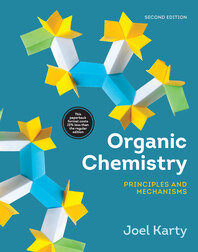
Organic Chemistry
Principles and Mechanisms
Second Edition
18 January 2019
Territory Rights — Worldwide.
A MECHANISTIC ORGANISATION
Organic chemistry students often try to memorise their way through the course. An organisation by mechanism helps prevent this because each reaction chapter focuses primarily on the importance of understanding reaction mechanisms.
A key to Joel’s organisation is Chapter 7: An Overview of the Most Common Elementary Steps. In it, students are introduced to 9 of the 10 mechanisms they will see for most of the course. This lays the foundation for students to build on by foreshadowing what’s to come. It also makes students more comfortable and confident in using mechanisms throughout the course.
“THINK” AND “SOLVE” IN THE TEXT AND SMARTWORK5
In every worked problem, Joel Karty presents the solution in two steps: Think and Solve. The “Think” step sets this book apart as it promotes active learning and poses the kinds of questions a student should be asking as they approach this type of problem.
Smartwork5 offers a sophisticated, yet user-friendly platform. Tying directly to the text's organisation and pedagogy, it includes extensive answer-specific feedback and hints using the “Think” and “Solve” steps.
A variety of interactive question types, including Smartwork5’s intuitive 2D molecular drawing tool, test student understanding and reinforce problem-solving skills. In addition, Smartwork5 can now be used on a tablet and integrates seamlessly with campus LMSs.
PEDAGOGY THAT FACILITATES ACTIVE LEARNING
Active-learning exercises, called Your Turn, are integrated into each chapter. These exercises motivate students to work problems and interact with figures as part of their reading. Your Turn questions also act as reality checks to indicate whether a student understands what they just read.
The Your Turn questions are live, clickable links in the ebook, so students can get immediate feedback and determine whether they truly understand the material. In addition, you can click on Solved Problems to reveal the “Think” and then “Solve” steps in the ebook.
APPLICATIONS MAKE ORGANIC CHEMISTRY RELEVANT TO NON-CHEMISTRY MAJORS
Rather than relegating biochemistry to the last chapters of the book, coverage of biochemical material is in self-contained sections at the end of several chapters, beginning with Chapter 1. In each Organic Chemistry of Biomolecules section, Karty draws explicit links to concepts encountered earlier in the chapter. These biochemistry sections are both optional and flexible.
NEW COVERAGE ON CONTEMPORARY TOPICS AND MODERN REACTIONS
Based on user and reviewer feedback, new material has been added to the Second Edition, including:
• A NEW Green Chemistry section in Chapter 13 presents fundamental ideas behind green chemistry. In subsequent chapters, Green Chemistry boxes highlight green aspects of some reactions and provide examples of green alternatives to others.
• A NEW section on transition metal coupling reactions and alkene metathesis reactions (Section 19.7) gives students access to Nobel prize–winning chemistry.
Organic chemistry students often try to memorise their way through the course. An organisation by mechanism helps prevent this because each reaction chapter focuses primarily on the importance of understanding reaction mechanisms.
A key to Joel’s organisation is Chapter 7: An Overview of the Most Common Elementary Steps. In it, students are introduced to 9 of the 10 mechanisms they will see for most of the course. This lays the foundation for students to build on by foreshadowing what’s to come. It also makes students more comfortable and confident in using mechanisms throughout the course.
“THINK” AND “SOLVE” IN THE TEXT AND SMARTWORK5
In every worked problem, Joel Karty presents the solution in two steps: Think and Solve. The “Think” step sets this book apart as it promotes active learning and poses the kinds of questions a student should be asking as they approach this type of problem.
Smartwork5 offers a sophisticated, yet user-friendly platform. Tying directly to the text's organisation and pedagogy, it includes extensive answer-specific feedback and hints using the “Think” and “Solve” steps.
A variety of interactive question types, including Smartwork5’s intuitive 2D molecular drawing tool, test student understanding and reinforce problem-solving skills. In addition, Smartwork5 can now be used on a tablet and integrates seamlessly with campus LMSs.
PEDAGOGY THAT FACILITATES ACTIVE LEARNING
Active-learning exercises, called Your Turn, are integrated into each chapter. These exercises motivate students to work problems and interact with figures as part of their reading. Your Turn questions also act as reality checks to indicate whether a student understands what they just read.
The Your Turn questions are live, clickable links in the ebook, so students can get immediate feedback and determine whether they truly understand the material. In addition, you can click on Solved Problems to reveal the “Think” and then “Solve” steps in the ebook.
APPLICATIONS MAKE ORGANIC CHEMISTRY RELEVANT TO NON-CHEMISTRY MAJORS
Rather than relegating biochemistry to the last chapters of the book, coverage of biochemical material is in self-contained sections at the end of several chapters, beginning with Chapter 1. In each Organic Chemistry of Biomolecules section, Karty draws explicit links to concepts encountered earlier in the chapter. These biochemistry sections are both optional and flexible.
NEW COVERAGE ON CONTEMPORARY TOPICS AND MODERN REACTIONS
Based on user and reviewer feedback, new material has been added to the Second Edition, including:
• A NEW Green Chemistry section in Chapter 13 presents fundamental ideas behind green chemistry. In subsequent chapters, Green Chemistry boxes highlight green aspects of some reactions and provide examples of green alternatives to others.
• A NEW section on transition metal coupling reactions and alkene metathesis reactions (Section 19.7) gives students access to Nobel prize–winning chemistry.



